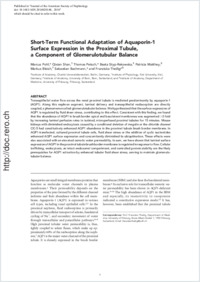Short-term functional adaptation of aquaporin-1 surface expression in the proximal tubule, a component of glomerulotubular balance
- Pohl, Marcus Institute of Anatomy, Charité Universitätsmedizin, Berlin, Germany
- Shan, Qixian Institute of Physiology, Kiel University, Germany
- Petsch, Thomas Institute of Anatomy, Charité Universitätsmedizin, Berlin, Germany
- Styp-Rekowska, Beata Institute of Anatomy, University of Bern, Switzerland
- Matthey, Patricia Institute of Anatomy, Department of Medicine, University of Fribourg, Switzerland
- Bleich, Markus Institute of Physiology, Kiel University, Germany
- Bachmann, Sebastian Institute of Anatomy, Charité Universitätsmedizin, Berlin, Germany
- Theilig, Franziska Institute of Anatomy, Charité Universitätsmedizin, Berlin, Germany - Institute of Anatomy, Department of Medicine, University of Fribourg, Switzerland
-
30.09.2014
Published in:
- Journal of the American Society of Nephrology. - 2014, p. ASN.2014020148
English
Transepithelial water flow across the renal proximal tubule is mediated predominantly by aquaporin-1 (AQP1). Along this nephron segment, luminal delivery and transepithelial reabsorption are directly coupled, a phenomenon called glomerulotubular balance. We hypothesized that the surface expression of AQP1 is regulated by fluid shear stress, contributing to this effect. Consistent with this finding, we found that the abundance of AQP1 in brush border apical and basolateral membranes was augmented >2-fold by increasing luminal perfusion rates in isolated, microperfused proximal tubules for 15 minutes. Mouse kidneys with diminished endocytosis caused by a conditional deletion of megalin or the chloride channel ClC-5 had constitutively enhanced AQP1 abundance in the proximal tubule brush border membrane. In AQP1-transfected, cultured proximal tubule cells, fluid shear stress or the addition of cyclic nucleotides enhanced AQP1 surface expression and concomitantly diminished its ubiquitination. These effects were also associated with an elevated osmotic water permeability. In sum, we have shown that luminal surface expression of AQP1 in the proximal tubule brush border membrane is regulated in response to flow. Cellular trafficking, endocytosis, an intact endosomal compartment, and controlled protein stability are the likely prerequisites for AQP1 activation by enhanced tubular fluid shear stress, serving to maintain glomerulotubular balance.
- Faculty
- Faculté des sciences et de médecine
- Department
- Département de Médecine
- Language
-
- English
- Classification
- Biological sciences
- License
- License undefined
- Identifiers
-
- RERO DOC 233201
- DOI 10.1681/ASN.2014020148
- Persistent URL
- https://folia.unifr.ch/unifr/documents/303979
Other files
Statistics
Document views: 63
File downloads:
- the_stf.pdf: 157
- the_stf_sm.pdf: 108

